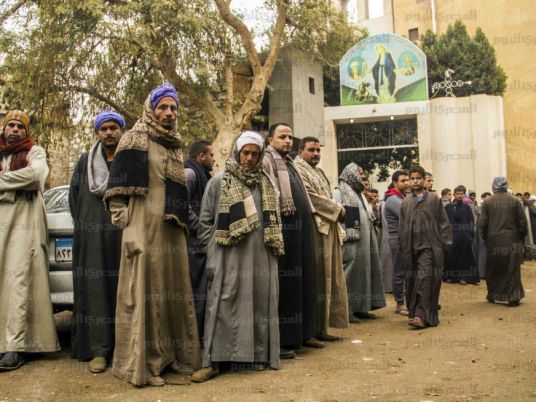Despite growing sectarian tensions in recent years, the Egyptian people have adamantly expressed their unity since the start of mass demonstrations on 25 January.
The message delivered by protesters in Cairo’s Tahrir Square was unequivocal: Egyptians are fighting side by side to end President Hosni Mubarak’s regime, and religion does not factor into the equation.
“Look around you,” says Mohamed Helmy, a magazine editor, standing in the square at around noon Monday. “There are men, women, old people, young people, poor and rich, Muslims and Christians… Egyptians from all walks of life have a common goal: Getting rid of Mubarak.”
Among the thousands of people gathered on the central square chanting anti-regime slogans, exchanging information and marching peacefully, poster bearing crescents and crosses drawn in thick black ink.
A young Muslim man held a placard with a crescent and cross under the motto “Long live Egypt.” He explains its significance: “Mubarak is the one who created a “fitna” [rift] between the Muslims and the Christians in Egypt over the past 30 years.”
A nearby demonstrator, whose puffy eyes betray a week of little sleep, overhears the conversation and interrupts: “Why do you think no churches or mosques have been attacked since all police forces were removed from the city two days ago? It’s because places of worship have been protected by the population, and the neighborhood patrols.”
Pointing to a mosque on a street adjacent to the square he says, “Wounded Coptic women were taken to the mosque there and protected from the madness going on outside Friday.”
Suddenly the voice of the muezzins (prayer caller) calms the general agitation as rows of men bow in prayer. Time seems suspended while the men pray, and Christian demonstrators standing close by.
“This is the first time I came downtown to check on the demonstrations to get a feeling of what is happening,” says Magdy, a Coptic librarian from Darassa. “To be honest, I was worried that the Muslim Brothers would have an overwhelming presence in the demonstrations, but now I see that many opposition forces are present and it seems balanced.”
He adds that he is happy to see Muslims and Christians fighting side-by-side in a common war, but is skeptical about how long such unity will last. “People are fighting together right now because they have a common problem. But as soon as the situation settles down, I’m afraid the old dissentions may reappear.”
Protester Abdelrahman Mohamed Abdelrahman, a lawyer affiliated with the Muslim Brotherhood, says : “Christians and Muslims are hand in hand, we have been the victims of a dictatorship for 30 years and have all experienced unemployment, corruption, lack of freedom, perspective and fair elections.”
Calling for “liberty, work, a decent lifestyle, fair elections and social reforms,” Abdelrahman sums up the demands of the popular movement. “I believe the people of Egypt have managed to create unity despite the tensions both communities have experienced in the past, and that this unity will remain after the revolution is over,” he says.
A middle-aged Muslim woman holding her two children by their hands confirms the general impression of unity between the two disparate groups. “We are brothers, we all eat from the same plate” she says.
A Muslim man walking with his wife asks “How can you even imagine for a second that we are not all united in this fight? On 1 January when the church in Alexandria was attacked by the terrorists I went there as soon as I could.”
His wife, who wears a niqab, teaches at a Franciscan school attended by Muslims and Christians. “Why would I care? For the past 30 years, Mubarak has played the divide-and-conquer game with his people,” she says.
One young protester, Zakaria, an engineer, says: “We have an expression ‘Me and my brother against my cousin, and me and my cousin against a stranger.’ The idea is that if there are two Egyptians from the same neighborhood who are fighting, and if someone comes from another neighborhood and tries to fight with either of them, the two just become one hand and they forget their differences.”
In Garden City, a neighborhood of downtown, a group of young Christians are spotted chatting, casually leaning against a car. Armed with sticks, they have been patrolling the streets for the entire night. The nearby church, they say, was protected against looters and vandals by all local residents, regardless of religious affiliation. Grinning, they say, “The bamboo sticks we used to scare off the looters were used previously to build our Christmas nativity scene.”


